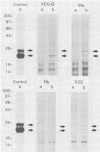Abstract
Autocrine growth factors are believed to be important for maintenance of an immortalized state by Epstein-Barr virus (EBV), because cell-free supernatants of EBV-immortalized cell lines promote the proliferation of autologous cells and permit their growth at low cell density. In this study, we provide evidence for the existence of two autocrine growth factor activities produced by EBV-immortalized lines distinguished by size and biological activities. Much of the autocrine growth factor activity in lymphoblastoid cell line supernatants resided in a low-molecular-weight (less than 5,000) fraction. However, up to 20 to 30% of the autocrine growth factor activity resided in the high-molecular-weight (greater than 5,000) fraction. While the nature of the low-molecular-weight growth factor activity remains undefined, the high-molecular-weight growth factor activity was identified as interleukin-6 (IL-6). Culture supernatants from six EBV-induced lymphoblastoid cell lines tested contained IL-6 activity, because they promoted proliferation in the IL-6-dependent hybridoma cell line B9. In addition, a rabbit antibody to human IL-6 neutralized the capacity of the high-molecular-weight (greater than 5,000) fraction of a lymphoblastoid cell line supernatant to promote growth both in autologous EBV-immortalized cells and in B9 cells. Similarly, this high-molecular-weight autocrine growth factor activity was neutralized by a monoclonal antibody to human IL-6. Furthermore, characteristic bands, attributable to IL-6, were visualized in supernatants of each of four EBV-induced lymphoblastoid cell lines after immunoprecipitation with a rabbit antiserum to human IL-6. Thus, in addition to its previously reported properties, IL-6 is an autocrine growth factor for EBV-immortalized B cells cultured under serum-free conditions.
Full text
PDF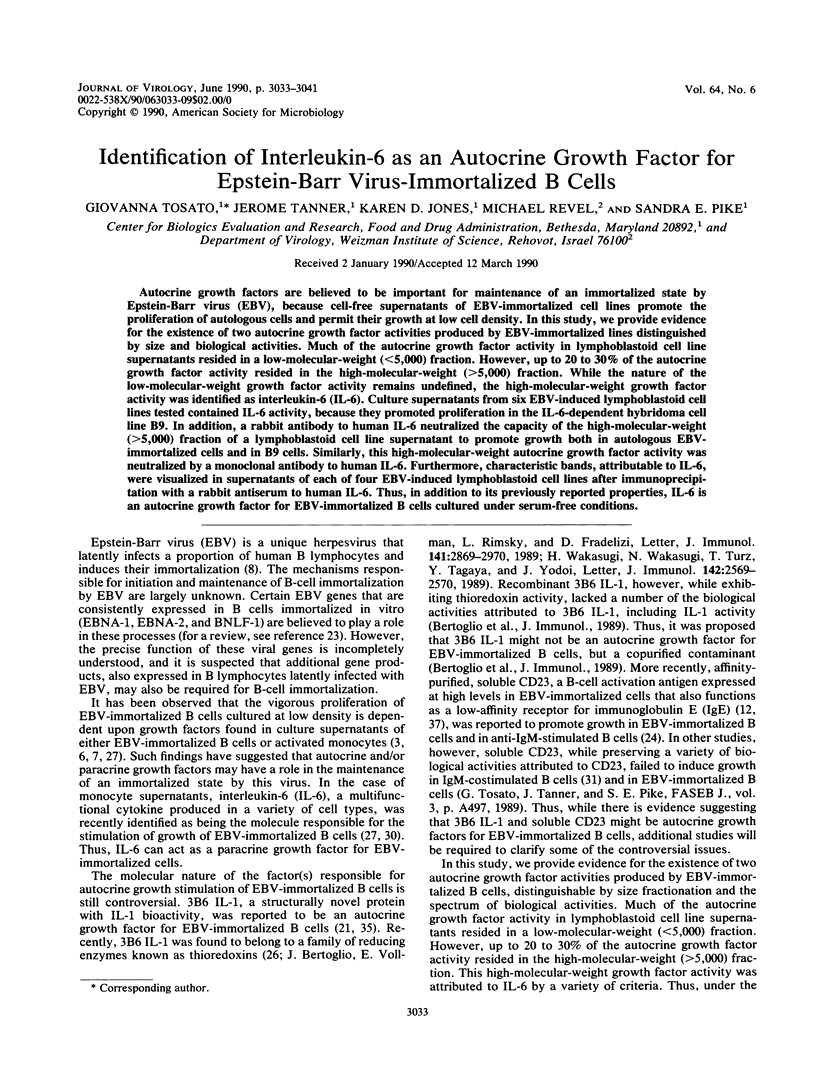
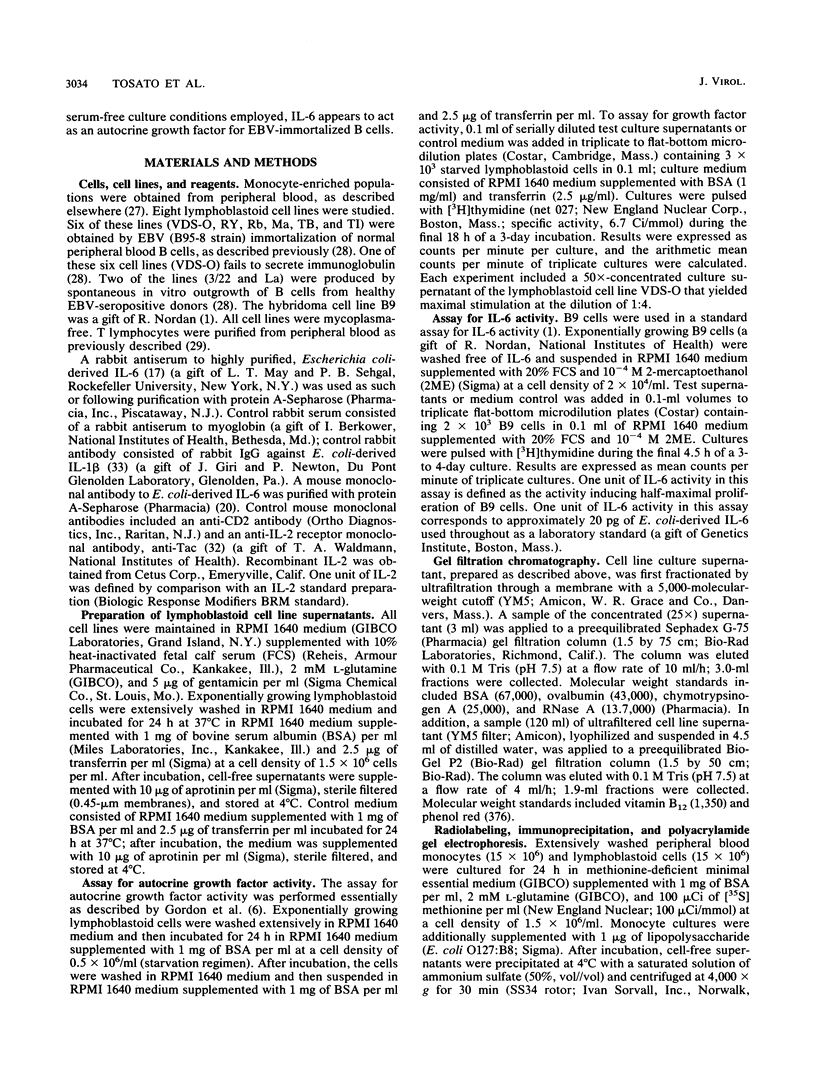
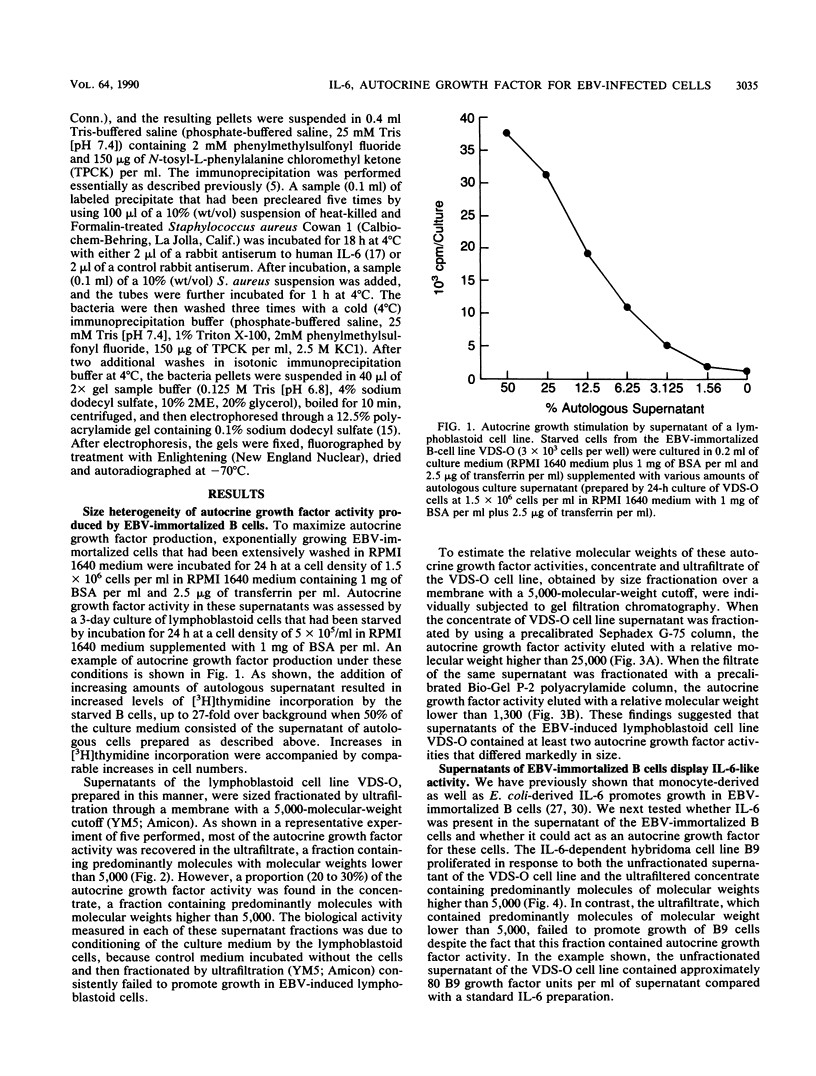
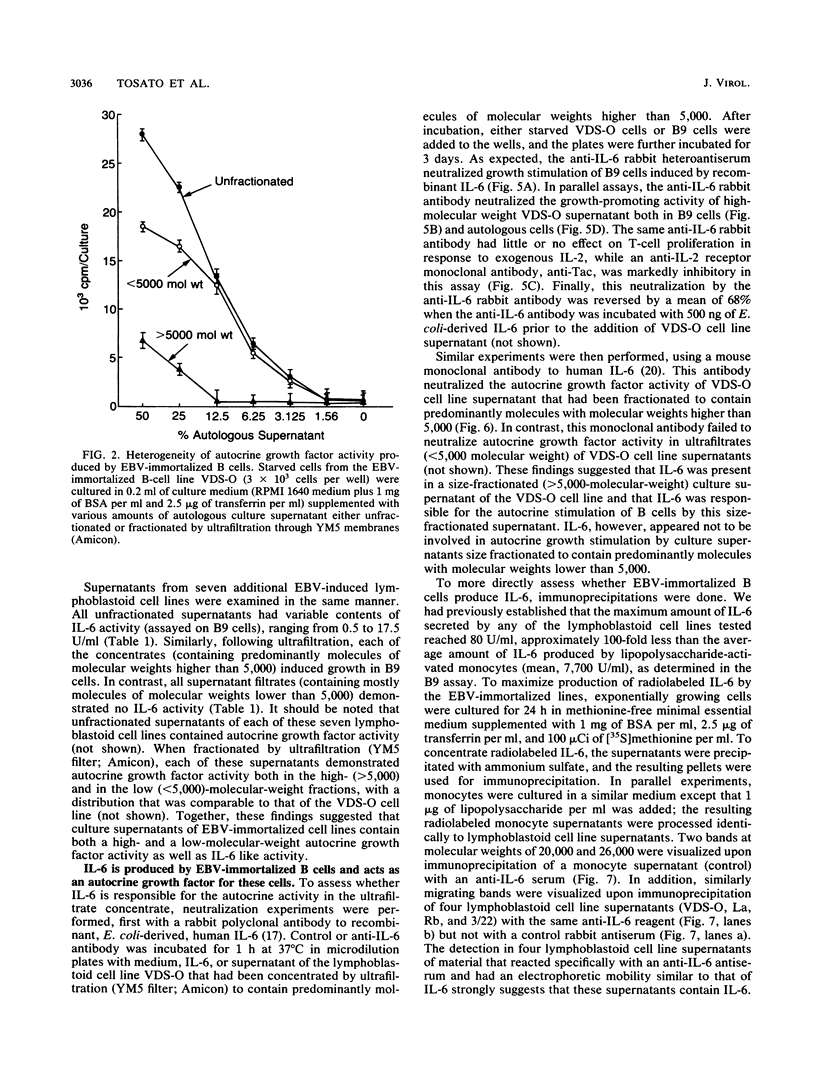
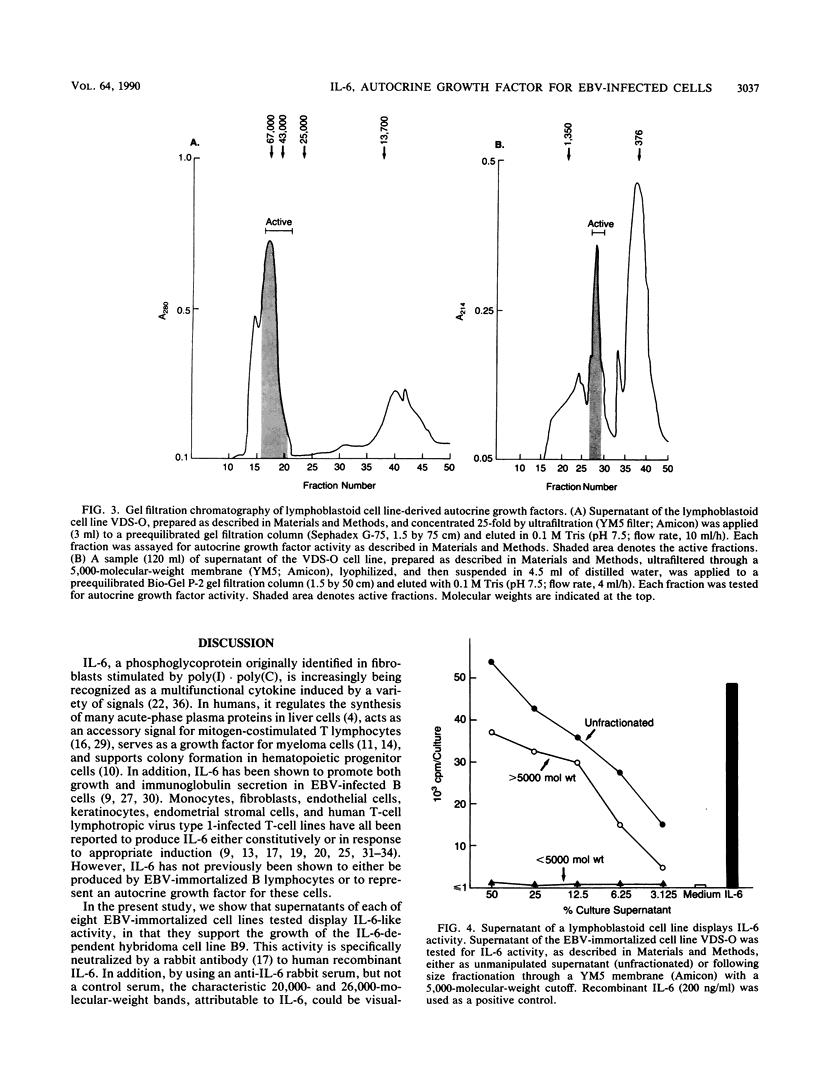
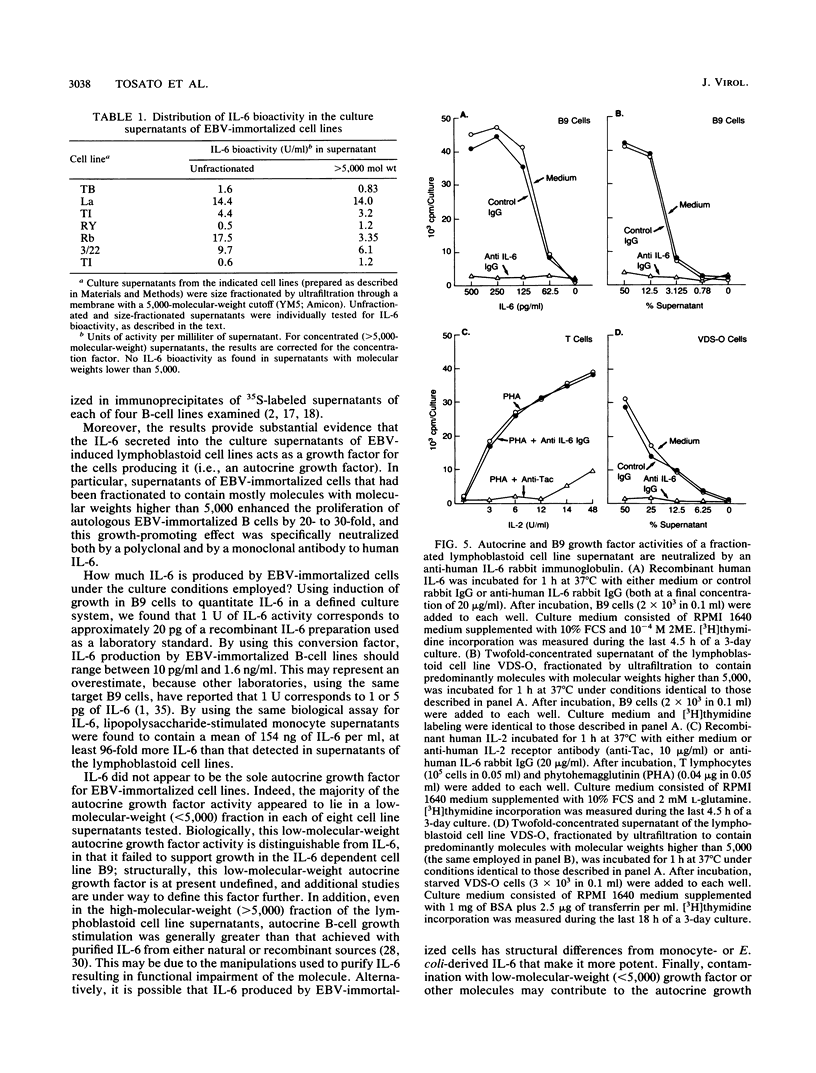
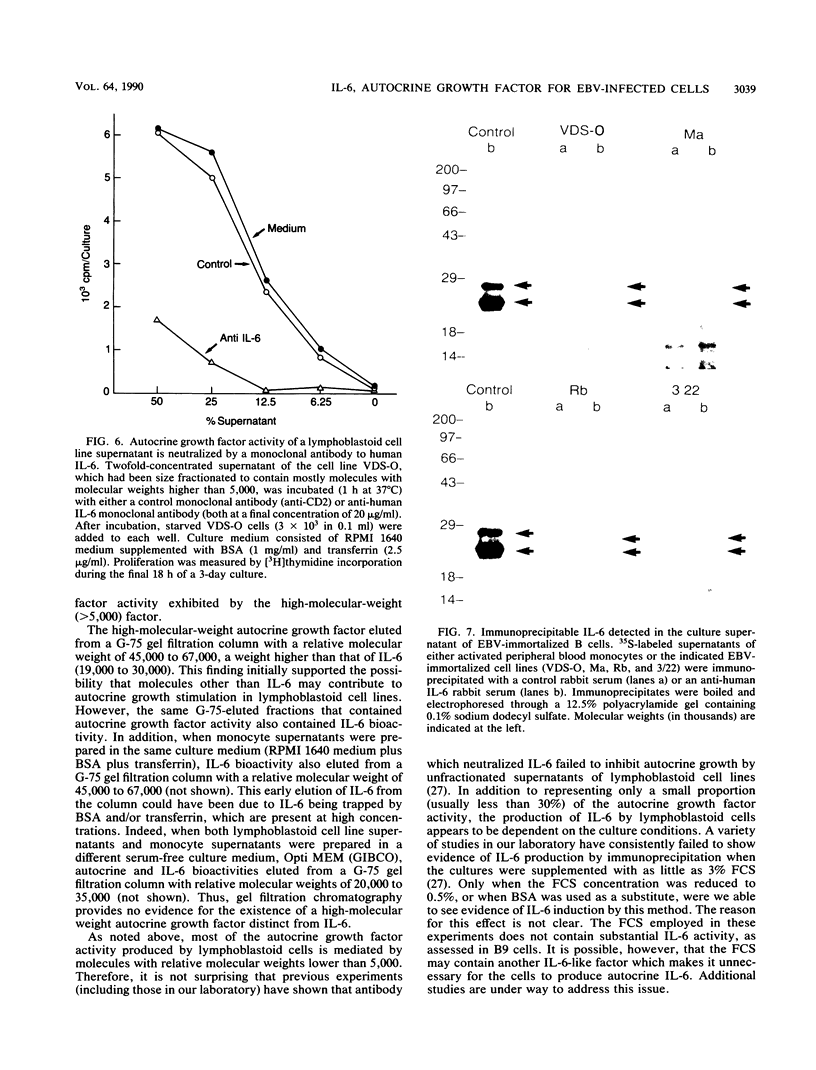
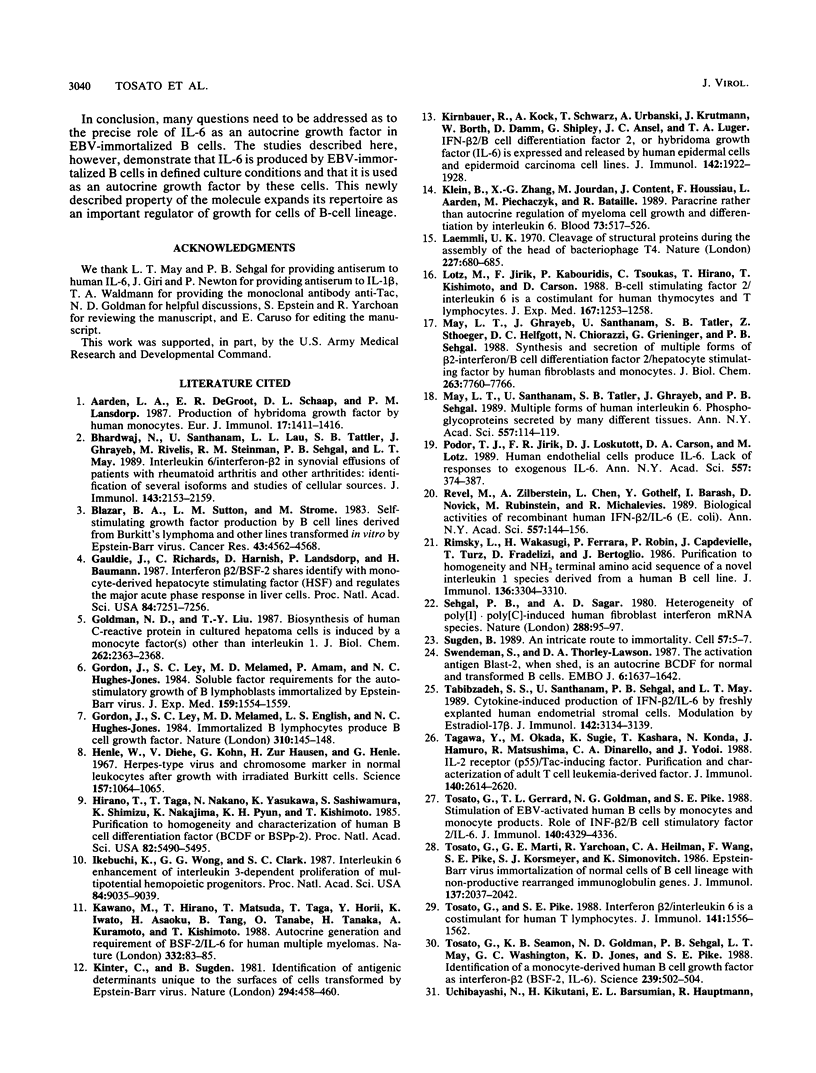
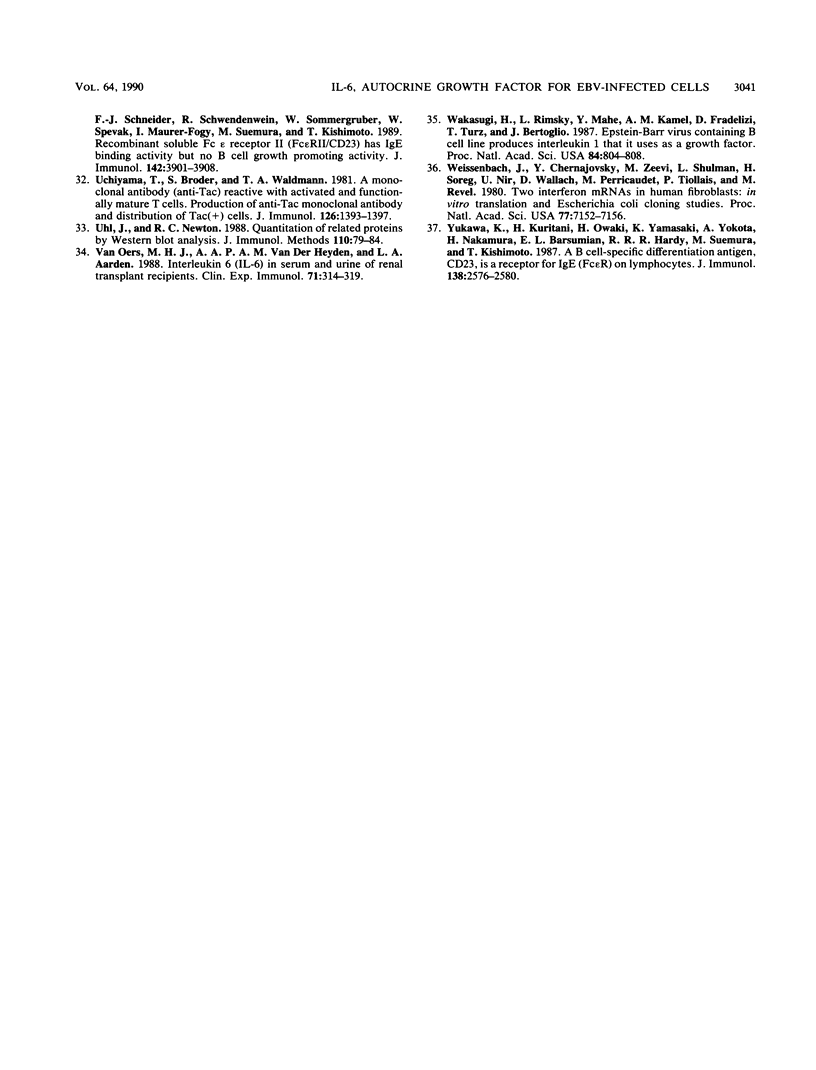
Images in this article
Selected References
These references are in PubMed. This may not be the complete list of references from this article.
- Aarden L. A., De Groot E. R., Schaap O. L., Lansdorp P. M. Production of hybridoma growth factor by human monocytes. Eur J Immunol. 1987 Oct;17(10):1411–1416. doi: 10.1002/eji.1830171004. [DOI] [PubMed] [Google Scholar]
- Bhardwaj N., Santhanam U., Lau L. L., Tatter S. B., Ghrayeb J., Rivelis M., Steinman R. M., Sehgal P. B., May L. T. IL-6/IFN-beta 2 in synovial effusions of patients with rheumatoid arthritis and other arthritides. Identification of several isoforms and studies of cellular sources. J Immunol. 1989 Oct 1;143(7):2153–2159. [PubMed] [Google Scholar]
- Blazar B. A., Sutton L. M., Strome M. Self-stimulating growth factor production by B-cell lines derived from Burkitt's lymphomas and other lines transformed in vitro by Epstein-Barr virus. Cancer Res. 1983 Oct;43(10):4562–4568. [PubMed] [Google Scholar]
- Gauldie J., Richards C., Harnish D., Lansdorp P., Baumann H. Interferon beta 2/B-cell stimulatory factor type 2 shares identity with monocyte-derived hepatocyte-stimulating factor and regulates the major acute phase protein response in liver cells. Proc Natl Acad Sci U S A. 1987 Oct;84(20):7251–7255. doi: 10.1073/pnas.84.20.7251. [DOI] [PMC free article] [PubMed] [Google Scholar]
- Goldman N. D., Liu T. Y. Biosynthesis of human C-reactive protein in cultured hepatoma cells is induced by a monocyte factor(s) other than interleukin-1. J Biol Chem. 1987 Feb 15;262(5):2363–2368. [PubMed] [Google Scholar]
- Gordon J., Ley S. C., Melamed M. D., Aman P., Hughes-Jones N. C. Soluble factor requirements for the autostimulatory growth of B lymphoblasts immortalized by Epstein-Barr virus. J Exp Med. 1984 May 1;159(5):1554–1559. doi: 10.1084/jem.159.5.1554. [DOI] [PMC free article] [PubMed] [Google Scholar]
- Gordon J., Ley S. C., Melamed M. D., English L. S., Hughes-Jones N. C. Immortalized B lymphocytes produce B-cell growth factor. Nature. 1984 Jul 12;310(5973):145–147. doi: 10.1038/310145a0. [DOI] [PubMed] [Google Scholar]
- Henle W., Diehl V., Kohn G., Zur Hausen H., Henle G. Herpes-type virus and chromosome marker in normal leukocytes after growth with irradiated Burkitt cells. Science. 1967 Sep 1;157(3792):1064–1065. doi: 10.1126/science.157.3792.1064. [DOI] [PubMed] [Google Scholar]
- Hirano T., Taga T., Nakano N., Yasukawa K., Kashiwamura S., Shimizu K., Nakajima K., Pyun K. H., Kishimoto T. Purification to homogeneity and characterization of human B-cell differentiation factor (BCDF or BSFp-2). Proc Natl Acad Sci U S A. 1985 Aug;82(16):5490–5494. doi: 10.1073/pnas.82.16.5490. [DOI] [PMC free article] [PubMed] [Google Scholar]
- Ikebuchi K., Wong G. G., Clark S. C., Ihle J. N., Hirai Y., Ogawa M. Interleukin 6 enhancement of interleukin 3-dependent proliferation of multipotential hemopoietic progenitors. Proc Natl Acad Sci U S A. 1987 Dec;84(24):9035–9039. doi: 10.1073/pnas.84.24.9035. [DOI] [PMC free article] [PubMed] [Google Scholar]
- Kawano M., Hirano T., Matsuda T., Taga T., Horii Y., Iwato K., Asaoku H., Tang B., Tanabe O., Tanaka H. Autocrine generation and requirement of BSF-2/IL-6 for human multiple myelomas. Nature. 1988 Mar 3;332(6159):83–85. doi: 10.1038/332083a0. [DOI] [PubMed] [Google Scholar]
- Kintner C., Sugden B. Identification of antigenic determinants unique to the surfaces of cells transformed by Epstein-Barr virus. Nature. 1981 Dec 3;294(5840):458–460. doi: 10.1038/294458a0. [DOI] [PubMed] [Google Scholar]
- Kirnbauer R., Köck A., Schwarz T., Urbanski A., Krutmann J., Borth W., Damm D., Shipley G., Ansel J. C., Luger T. A. IFN-beta 2, B cell differentiation factor 2, or hybridoma growth factor (IL-6) is expressed and released by human epidermal cells and epidermoid carcinoma cell lines. J Immunol. 1989 Mar 15;142(6):1922–1928. [PubMed] [Google Scholar]
- Klein B., Zhang X. G., Jourdan M., Content J., Houssiau F., Aarden L., Piechaczyk M., Bataille R. Paracrine rather than autocrine regulation of myeloma-cell growth and differentiation by interleukin-6. Blood. 1989 Feb;73(2):517–526. [PubMed] [Google Scholar]
- Laemmli U. K. Cleavage of structural proteins during the assembly of the head of bacteriophage T4. Nature. 1970 Aug 15;227(5259):680–685. doi: 10.1038/227680a0. [DOI] [PubMed] [Google Scholar]
- Lotz M., Jirik F., Kabouridis P., Tsoukas C., Hirano T., Kishimoto T., Carson D. A. B cell stimulating factor 2/interleukin 6 is a costimulant for human thymocytes and T lymphocytes. J Exp Med. 1988 Mar 1;167(3):1253–1258. doi: 10.1084/jem.167.3.1253. [DOI] [PMC free article] [PubMed] [Google Scholar]
- May L. T., Ghrayeb J., Santhanam U., Tatter S. B., Sthoeger Z., Helfgott D. C., Chiorazzi N., Grieninger G., Sehgal P. B. Synthesis and secretion of multiple forms of beta 2-interferon/B-cell differentiation factor 2/hepatocyte-stimulating factor by human fibroblasts and monocytes. J Biol Chem. 1988 Jun 5;263(16):7760–7766. [PubMed] [Google Scholar]
- May L. T., Santhanam U., Tatter S. B., Ghrayeb J., Sehgal P. B. Multiple forms of human interleukin-6. Phosphoglycoproteins secreted by many different tissues. Ann N Y Acad Sci. 1989;557:114–121. [PubMed] [Google Scholar]
- Podor T. J., Jirik F. R., Loskutoff D. J., Carson D. A., Lotz M. Human endothelial cells produce IL-6. Lack of responses to exogenous IL-6. Ann N Y Acad Sci. 1989;557:374–387. [PubMed] [Google Scholar]
- Revel M., Zilberstein A., Chen L., Gothelf Y., Barash I., Novick D., Rubinstein M., Michalevicz R. Biological activities of recombinant human IFN-beta 2/IL-6 (E. coli). Ann N Y Acad Sci. 1989;557:144-55, discussion 156. [PubMed] [Google Scholar]
- Rimsky L., Wakasugi H., Ferrara P., Robin P., Capdevielle J., Tursz T., Fradelizi D., Bertoglio J. Purification to homogeneity and NH2-terminal amino acid sequence of a novel interleukin 1 species derived from a human B cell line. J Immunol. 1986 May 1;136(9):3304–3310. [PubMed] [Google Scholar]
- Sehgal P. B., Sagar A. D. Heterogeneity of poly(I) x poly(C)-induced human fibroblast interferon mRNA species. Nature. 1980 Nov 6;288(5786):95–97. doi: 10.1038/288095a0. [DOI] [PubMed] [Google Scholar]
- Sugden B. An intricate route to immortality. Cell. 1989 Apr 7;57(1):5–7. doi: 10.1016/0092-8674(89)90165-7. [DOI] [PubMed] [Google Scholar]
- Swendeman S., Thorley-Lawson D. A. The activation antigen BLAST-2, when shed, is an autocrine BCGF for normal and transformed B cells. EMBO J. 1987 Jun;6(6):1637–1642. doi: 10.1002/j.1460-2075.1987.tb02412.x. [DOI] [PMC free article] [PubMed] [Google Scholar]
- Tabibzadeh S. S., Santhanam U., Sehgal P. B., May L. T. Cytokine-induced production of IFN-beta 2/IL-6 by freshly explanted human endometrial stromal cells. Modulation by estradiol-17 beta. J Immunol. 1989 May 1;142(9):3134–3139. [PubMed] [Google Scholar]
- Tagaya Y., Okada M., Sugie K., Kasahara T., Kondo N., Hamuro J., Matsushima K., Dinarello C. A., Yodoi J. IL-2 receptor(p55)/Tac-inducing factor. Purification and characterization of adult T cell leukemia-derived factor. J Immunol. 1988 Apr 15;140(8):2614–2620. [PubMed] [Google Scholar]
- Tosato G., Gerrard T. L., Goldman N. G., Pike S. E. Stimulation of EBV-activated human B cells by monocytes and monocyte products. Role of IFN-beta 2/B cell stimulatory factor 2/IL-6. J Immunol. 1988 Jun 15;140(12):4329–4336. [PubMed] [Google Scholar]
- Tosato G., Marti G. E., Yarchoan R., Heilman C. A., Wang F., Pike S. E., Korsmeyer S. J., Siminovitch K. Epstein-Barr virus immortalization of normal cells of B cell lineage with nonproductive, rearranged immunoglobulin genes. J Immunol. 1986 Sep 15;137(6):2037–2042. [PubMed] [Google Scholar]
- Tosato G., Pike S. E. Interferon-beta 2/interleukin 6 is a co-stimulant for human T lymphocytes. J Immunol. 1988 Sep 1;141(5):1556–1562. [PubMed] [Google Scholar]
- Tosato G., Seamon K. B., Goldman N. D., Sehgal P. B., May L. T., Washington G. C., Jones K. D., Pike S. E. Monocyte-derived human B-cell growth factor identified as interferon-beta 2 (BSF-2, IL-6). Science. 1988 Jan 29;239(4839):502–504. doi: 10.1126/science.2829354. [DOI] [PubMed] [Google Scholar]
- Uchibayashi N., Kikutani H., Barsumian E. L., Hauptmann R., Schneider F. J., Schwendenwein R., Sommergruber W., Spevak W., Maurer-Fogy I., Suemura M. Recombinant soluble Fc epsilon receptor II (Fc epsilon RII/CD23) has IgE binding activity but no B cell growth promoting activity. J Immunol. 1989 Jun 1;142(11):3901–3908. [PubMed] [Google Scholar]
- Uchiyama T., Broder S., Waldmann T. A. A monoclonal antibody (anti-Tac) reactive with activated and functionally mature human T cells. I. Production of anti-Tac monoclonal antibody and distribution of Tac (+) cells. J Immunol. 1981 Apr;126(4):1393–1397. [PubMed] [Google Scholar]
- Uhl J., Newton R. C. Quantitation of related proteins by Western blot analysis. J Immunol Methods. 1988 May 25;110(1):79–84. doi: 10.1016/0022-1759(88)90085-3. [DOI] [PubMed] [Google Scholar]
- Van Oers M. H., Van der Heyden A. A., Aarden L. A. Interleukin 6 (IL-6) in serum and urine of renal transplant recipients. Clin Exp Immunol. 1988 Feb;71(2):314–319. [PMC free article] [PubMed] [Google Scholar]
- Wakasugi H., Rimsky L., Mahe Y., Kamel A. M., Fradelizi D., Tursz T., Bertoglio J. Epstein-Barr virus-containing B-cell line produces an interleukin 1 that it uses as a growth factor. Proc Natl Acad Sci U S A. 1987 Feb;84(3):804–808. doi: 10.1073/pnas.84.3.804. [DOI] [PMC free article] [PubMed] [Google Scholar]
- Weissenbach J., Chernajovsky Y., Zeevi M., Shulman L., Soreq H., Nir U., Wallach D., Perricaudet M., Tiollais P., Revel M. Two interferon mRNAs in human fibroblasts: in vitro translation and Escherichia coli cloning studies. Proc Natl Acad Sci U S A. 1980 Dec;77(12):7152–7156. doi: 10.1073/pnas.77.12.7152. [DOI] [PMC free article] [PubMed] [Google Scholar]
- Yukawa K., Kikutani H., Owaki H., Yamasaki K., Yokota A., Nakamura H., Barsumian E. L., Hardy R. R., Suemura M., Kishimoto T. A B cell-specific differentiation antigen, CD23, is a receptor for IgE (Fc epsilon R) on lymphocytes. J Immunol. 1987 Apr 15;138(8):2576–2580. [PubMed] [Google Scholar]



